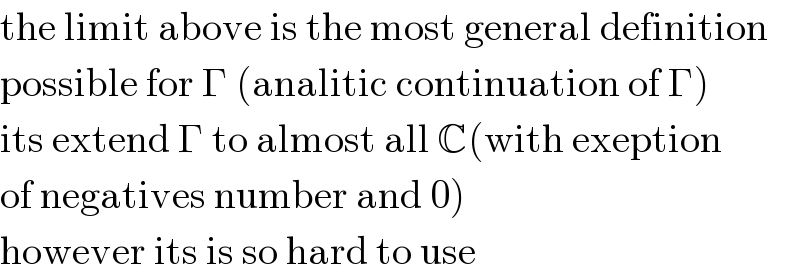Question Number 2891 by 123456 last updated on 29/Nov/15

$$\mathrm{given} \\ $$$$\Gamma\left({z}\right)=\underset{{n}\rightarrow+\infty} {\mathrm{lim}}\:\frac{{n}!}{{z}\left({z}+\mathrm{1}\right)\centerdot\centerdot\centerdot\left({z}+{n}\right)}{n}^{{z}} \\ $$$$\mathrm{proof}\:\mathrm{that} \\ $$$$\left.{i}\right) \\ $$$$\Gamma\left({z}+\mathrm{1}\right)={z}\Gamma\left({z}\right) \\ $$$$\left.{ii}\right)\:\mathrm{wiertrass}\:\mathrm{definition}\:\mathrm{of}\:\mathrm{gamma}\:\mathrm{function} \\ $$$$\frac{\mathrm{1}}{\Gamma\left({z}\right)}={ze}^{{z}\gamma} \underset{{m}=\mathrm{1}} {\overset{+\infty} {\prod}}\:\left(\mathrm{1}+\frac{{z}}{{m}}\right){e}^{−\frac{{z}}{{m}}} \\ $$$$\gamma\:\mathrm{is}\:\mathrm{euler}\:\mathrm{macheroni}\:\mathrm{constant}\:\left(\mathrm{Q2818},\mathrm{Q2783}\right) \\ $$
Commented by Filup last updated on 30/Nov/15

$${z}\left({z}+\mathrm{1}\right)\left({z}+\mathrm{2}\right)\centerdot\centerdot\centerdot\left({z}+{n}\right)=\frac{\left({z}+{n}\right)!}{\left({z}−\mathrm{1}\right)!} \\ $$$$\therefore\Gamma\left({z}\right)=\underset{{n}\rightarrow+\infty} {\mathrm{lim}}\frac{{n}!\centerdot\left({z}−\mathrm{1}\right)!}{\left({z}+{n}\right)!}\centerdot{n}^{{z}} \\ $$
Answered by Filup last updated on 30/Nov/15

$$\Gamma\left({z}\right)=\left({z}−\mathrm{1}\right)\left({z}−\mathrm{2}\right)\centerdot\centerdot\centerdot×\mathrm{3}×\mathrm{2}×\mathrm{1} \\ $$$$\Gamma\left({z}+\mathrm{1}\right)={z}\left({z}−\mathrm{1}\right)\left({z}−\mathrm{2}\right)\centerdot\centerdot\centerdot×\mathrm{3}×\mathrm{2}×\mathrm{1} \\ $$$$\Gamma\left({z}+\mathrm{1}\right)={z}\Gamma\left({z}\right) \\ $$$$ \\ $$$$\mathrm{I}'\mathrm{m}\:\mathrm{sure}\:\mathrm{you}\:\mathrm{wanted}\:\mathrm{a}\:\mathrm{proof}\:\mathrm{in}\:\mathrm{terms}\:\mathrm{of} \\ $$$$\mathrm{the}\:\mathrm{limit}\:\mathrm{you}\:\mathrm{gave}\:\mathrm{above},\:\mathrm{but}\:\mathrm{I}\:\mathrm{am} \\ $$$$\mathrm{unsure}\:\mathrm{as}\:\mathrm{to}\:\mathrm{how}\:\mathrm{to}\:\mathrm{achieve}\:\mathrm{the}\:\mathrm{result} \\ $$$$\mathrm{you}\:\mathrm{most}\:\mathrm{likely}\:\mathrm{desired}.\:\mathrm{Maybe}\:\mathrm{you}\:\mathrm{can} \\ $$$$\mathrm{further}\:\mathrm{prove}\:\mathrm{by}\:\mathrm{applying}\:\mathrm{the}\:\mathrm{limit}? \\ $$$$ \\ $$$$\mathrm{I}\:\mathrm{shall}\:\mathrm{update}\:\mathrm{this}\:\mathrm{post}\:\mathrm{if}\:\mathrm{I}\:\mathrm{can}.\:\mathrm{I}\:{might} \\ $$$$\mathrm{have}\:\mathrm{an}\:\mathrm{idea}\:\mathrm{to}\:\mathrm{prove}\:\left({i}\right)\:\mathrm{in}\:\mathrm{terms} \\ $$$$\mathrm{of}\:\mathrm{the}\:\mathrm{limit} \\ $$
Commented by 123456 last updated on 30/Nov/15

$$\mathrm{the}\:\mathrm{limit}\:\mathrm{above}\:\mathrm{is}\:\mathrm{the}\:\mathrm{most}\:\mathrm{general}\:\mathrm{definition} \\ $$$$\mathrm{possible}\:\mathrm{for}\:\Gamma\:\left(\mathrm{analitic}\:\mathrm{continuation}\:\mathrm{of}\:\Gamma\right) \\ $$$$\mathrm{its}\:\mathrm{extend}\:\Gamma\:\mathrm{to}\:\mathrm{almost}\:\mathrm{all}\:\mathbb{C}\left(\mathrm{with}\:\mathrm{exeption}\right. \\ $$$$\left.\mathrm{of}\:\mathrm{negatives}\:\mathrm{number}\:\mathrm{and}\:\mathrm{0}\right) \\ $$$$\mathrm{however}\:\mathrm{its}\:\mathrm{is}\:\mathrm{so}\:\mathrm{hard}\:\mathrm{to}\:\mathrm{use} \\ $$
Commented by Filup last updated on 30/Nov/15

$$\mathrm{I}\:\mathrm{am}\:\mathrm{trying}\:\mathrm{a}\:\mathrm{method}\:\mathrm{of}\:\mathrm{proof}\:\mathrm{now}. \\ $$$$\mathrm{If}\:\mathrm{it}\:\mathrm{leads}\:\mathrm{nowhere},\:\mathrm{i}'\mathrm{ll}\:\mathrm{delete}\:\mathrm{my}\:\mathrm{2nd}\:\mathrm{post} \\ $$
Answered by Filup last updated on 30/Nov/15

$${Proof}\:{with}\:{limit} \\ $$$$\Gamma\left({z}\right)=\underset{{n}\rightarrow\infty} {\mathrm{lim}}\:\frac{{n}!}{{z}\left({z}+\mathrm{1}\right)\centerdot\centerdot\centerdot\left({z}+{n}\right)}{n}^{{z}} \\ $$$$\therefore\Gamma\left({z}\right)=\underset{{n}\rightarrow\infty} {\mathrm{lim}}\:\frac{{n}!\left({z}−\mathrm{1}\right)!}{\left({z}+{n}\right)!}{n}^{{z}} \\ $$$$ \\ $$$$\mathrm{Show}\:\mathrm{that}\:\Gamma\left({z}\right)=\left({z}−\mathrm{1}\right)\Gamma\left({z}−\mathrm{1}\right) \\ $$$$\therefore\underset{{n}\rightarrow\infty} {\mathrm{lim}}\:\frac{{n}!\left({z}−\mathrm{1}\right)!}{\left({z}+{n}\right)!}{n}^{{z}} =\left({z}−\mathrm{1}\right)\left(\underset{{n}\rightarrow\infty} {\mathrm{lim}}\:\frac{{n}!\left({z}−\mathrm{2}\right)!}{\left({z}+{n}−\mathrm{1}\right)!}{n}^{{z}−\mathrm{1}} \right) \\ $$$$\mathrm{Let}\:\mathrm{us}\:\mathrm{assume}\:\Gamma\left({z}\right)=\left({z}−\mathrm{1}\right)\Gamma\left({z}−\mathrm{1}\right).\:\mathrm{If}\:\mathrm{this}\:\mathrm{is} \\ $$$$\mathrm{true}\:\mathrm{then}\:\mathrm{LHS}=\mathrm{RHS} \\ $$$$ \\ $$$$\Gamma\left({x}\right)=\left({x}−\mathrm{1}\right)! \\ $$$$\underset{{n}\rightarrow\infty} {\mathrm{lim}}\:\frac{{n}!\centerdot\Gamma\left({z}\right)}{\Gamma\left({z}+{n}+\mathrm{1}\right)}{n}^{{z}} =\left({z}−\mathrm{1}\right)\left(\underset{{n}\rightarrow\infty} {\mathrm{lim}}\:\frac{{n}!\centerdot\Gamma\left({z}−\mathrm{1}\right)}{\Gamma\left({z}+{n}\right)}{n}^{{z}−\mathrm{1}} \right) \\ $$$$\therefore\underset{{n}\rightarrow\infty} {\mathrm{lim}}\:\frac{{n}!\centerdot\Gamma\left({z}\right)}{\Gamma\left({z}+{n}+\mathrm{1}\right)}{n}^{{z}} =\left({z}−\mathrm{1}\right)\left(\underset{{n}\rightarrow\infty} {\mathrm{lim}}\:\frac{{n}!\centerdot\frac{\Gamma\left({z}\right)}{{z}−\mathrm{1}}}{\frac{\Gamma\left({z}+{n}+\mathrm{1}\right)}{{z}−\mathrm{1}}}{n}^{{z}−\mathrm{1}} \right) \\ $$$$\therefore\underset{{n}\rightarrow\infty} {\mathrm{lim}}\:\frac{{n}!\centerdot\Gamma\left({z}\right)}{\Gamma\left({z}+{n}+\mathrm{1}\right)}{n}^{{z}} =\left({z}−\mathrm{1}\right)\left(\underset{{n}\rightarrow\infty} {\mathrm{lim}}\:\left(\frac{{n}!\centerdot\Gamma\left({z}\right)\centerdot\left({z}−\mathrm{1}\right)}{\left({z}−\mathrm{1}\right)\centerdot\Gamma\left({z}+{n}+\mathrm{1}\right)}\right){n}^{{z}−\mathrm{1}} \right) \\ $$$$\therefore\underset{{n}\rightarrow\infty} {\mathrm{lim}}\:\frac{{n}!\centerdot\Gamma\left({z}\right)}{\Gamma\left({z}+{n}+\mathrm{1}\right)}{n}^{{z}} =\underset{{n}\rightarrow\infty} {\mathrm{lim}}\:\frac{\left({z}−\mathrm{1}\right)\centerdot{n}!\centerdot\Gamma\left({z}\right)}{\Gamma\left({z}+{n}+\mathrm{1}\right)}{n}^{{z}−\mathrm{1}} \\ $$$$\Gamma\left({z}+{n}+\mathrm{1}\right)=\left({z}+{n}\right)! \\ $$$$\therefore\underset{{n}\rightarrow\infty} {\mathrm{lim}}\:\frac{{n}!\centerdot\Gamma\left({z}\right)}{\left({z}+{n}\right)!}{n}^{{z}} =\underset{{n}\rightarrow\infty} {\mathrm{lim}}\:\frac{{n}!\centerdot\Gamma\left({z}\right)^{\mathrm{2}} }{\left({z}+{n}\right)!\centerdot\Gamma\left({z}−\mathrm{1}\right)}{n}^{{z}−\mathrm{1}} \\ $$$$\therefore\underset{{n}\rightarrow\infty} {\mathrm{lim}}\:\frac{{n}!}{\left({z}+{n}\right)!}{n}^{{z}} =\underset{{n}\rightarrow\infty} {\mathrm{lim}}\:\frac{{n}!\centerdot\Gamma\left({z}\right)}{\left({z}+{n}\right)!\centerdot\Gamma\left({z}−\mathrm{1}\right)}{n}^{{z}−\mathrm{1}} \\ $$$$\therefore\underset{{n}\rightarrow\infty} {\mathrm{lim}}\:\frac{{n}!}{\left({z}+{n}\right)!}{n}^{{z}} =\underset{{n}\rightarrow\infty} {\mathrm{lim}}\:\frac{{n}!\centerdot\left({z}−\mathrm{1}\right)}{\left({z}+{n}\right)!}{n}^{{z}−\mathrm{1}} \\ $$$$\underset{{x}\rightarrow\infty} {\mathrm{lim}}\:\frac{{x}!}{\left({x}+{a}\right)!}=\mathrm{1}\:\:\:\:\:\:\:\:\:\:\:\:\left(?\right) \\ $$$$\therefore\underset{{n}\rightarrow\infty} {\mathrm{lim}}\:{n}^{{z}} =\underset{{n}\rightarrow\infty} {\mathrm{lim}}\:\left({z}−\mathrm{1}\right){n}^{{z}−\mathrm{1}} \\ $$$$\mathrm{TRUE} \\ $$$$\therefore\Gamma\left({z}+\mathrm{1}\right)={z}\Gamma\left({z}\right) \\ $$$$\mathrm{please}\:\mathrm{let}\:\mathrm{me}\:\mathrm{know}\:\mathrm{of}\:\mathrm{any}\:\mathrm{errors} \\ $$
Commented by 123456 last updated on 30/Nov/15

$$\Gamma\left({z}+\mathrm{1}\right)={z}\Gamma\left({z}\right) \\ $$$$\Gamma\left({z}\right)=\left({z}−\mathrm{1}\right)\Gamma\left({z}−\mathrm{1}\right) \\ $$
Commented by Filup last updated on 30/Nov/15

$$\mathrm{How}\:\mathrm{should}\:\mathrm{I}\:\mathrm{apply}\:\mathrm{this}? \\ $$
Commented by 123456 last updated on 30/Nov/15

$$\mathrm{you}\:\mathrm{have}\:\mathrm{a}\:\mathrm{typo}\:\mathrm{in}\:\mathrm{the}\:\mathrm{5th}\:\mathrm{line} \\ $$
Commented by Filup last updated on 30/Nov/15

$$\mathrm{T}{hanks}!\:{I}'{ll}\:{re}\:{read}\:{everything}! \\ $$$$\mathrm{I}\:\mathrm{believe}\:\mathrm{I}\:\mathrm{have}\:\mathrm{fixed}\:\mathrm{everything} \\ $$
Commented by 123456 last updated on 30/Nov/15

$$\mathrm{hint}:\:\frac{{x}}{{x}}=\mathrm{1},\underset{{n}\rightarrow\infty} {\mathrm{lim}}\frac{{n}+{a}}{{n}+{b}}=\mathrm{1} \\ $$$$\mathrm{try}\:\mathrm{to}\:\mathrm{write}\:\Gamma\left({z}\right)\:\mathrm{and}\:\Gamma\left({z}+\mathrm{1}\right) \\ $$$$\mathrm{and}\:\mathrm{compare}\:\mathrm{each}\:\mathrm{other}\:\mathrm{to}\:\mathrm{see}\:\mathrm{what} \\ $$$$\mathrm{you}\:\mathrm{need}\:\mathrm{to}\:\mathrm{manipulate}\::\mathrm{D} \\ $$$$\mathrm{ps}:\mathrm{if}\:\mathrm{you}\:\mathrm{want}\:\mathrm{i}\:\mathrm{can}\:\mathrm{post}\:\mathrm{the}\:\mathrm{proof}\:\mathrm{for}\:\mathrm{this} \\ $$$$\mathrm{part},\:\mathrm{but}\:\mathrm{try}\:\mathrm{to}\:\mathrm{do}\:\mathrm{it} \\ $$
Commented by Filup last updated on 30/Nov/15

$$\mathrm{I}'\mathrm{ll}\:\mathrm{let}\:\mathrm{you}\:\mathrm{know}\:\mathrm{if}\:\mathrm{i}\:\mathrm{can}'\mathrm{t}\:\mathrm{do}\:\mathrm{it}! \\ $$
Commented by Filup last updated on 30/Nov/15

$$\mathrm{Am}\:\mathrm{I}\:\mathrm{able}\:\mathrm{to}\:\mathrm{remove}\:\mathrm{like}\:\mathrm{terms}\:\mathrm{within} \\ $$$$\mathrm{limits}?\:\mathrm{e}.\mathrm{g}.: \\ $$$$\underset{{x}\rightarrow{n}} {\mathrm{lim}}\:{f}\left({x}\right)=\underset{{x}\rightarrow{n}} {\mathrm{lim}}\:{g}\left({x}\right) \\ $$$$\Rightarrow\underset{{x}\rightarrow{n}} {\mathrm{lim}}\:\frac{{f}\left({x}\right)}{{g}\left({x}\right)}=\mathrm{1} \\ $$
Commented by Filup last updated on 30/Nov/15

$$\mathrm{is}\:\mathrm{this}\:\mathrm{correct}? \\ $$
Answered by Yozzi last updated on 30/Nov/15

$$\left({i}\right)\:{We}\:{are}\:{given} \\ $$$$\:\:\:\:\:\:\:\:\:\:\:\:\:\:\:\:\:\:\:\Gamma\left({z}\right)=\underset{{n}\rightarrow+\infty} {\mathrm{lim}}\frac{{n}!{n}^{{z}} }{\underset{{r}=\mathrm{0}} {\overset{{n}} {\prod}}\left({z}+{r}\right)}.\: \\ $$$${Here}\:{I}\:{assume}\:{z}\:{is}\:{such}\:{that}\:{the}\: \\ $$$${function}\:\Gamma\left({z}\right)\:{is}\:{well}\:{defined}.\:{A}\: \\ $$$${possible}\:{constriction}\:{on}\:{the}\:{domain} \\ $$$${for}\:\Gamma\:{is}\:{z}>\mathrm{0}.\:{Therefore}\:{we}\:{have} \\ $$$$\Gamma\left({z}+\mathrm{1}\right)=\underset{{n}\rightarrow+\infty} {\mathrm{lim}}\frac{{n}!{n}^{{z}+\mathrm{1}} }{\left({z}+\mathrm{1}\right)\left({z}+\mathrm{2}\right)…\left({z}+{n}\right)\left({z}+{n}+\mathrm{1}\right)} \\ $$$$\Gamma\left({z}+\mathrm{1}\right)=\underset{{n}\rightarrow+\infty} {\mathrm{lim}}\frac{{n}!{n}^{{z}+\mathrm{1}} {z}}{\left\{\underset{{r}=\mathrm{0}} {\overset{{n}} {\prod}}\left({z}+{r}\right)\right\}\left({z}+\mathrm{1}+{n}\right)} \\ $$$$\Gamma\left({z}+\mathrm{1}\right)=\underset{{n}\rightarrow+\infty} {\mathrm{lim}}\left(\frac{{n}!{n}^{{z}} }{\underset{{r}=\mathrm{0}} {\overset{{n}} {\prod}}\left({z}+{r}\right)}\right)×\frac{{zn}}{{z}+\mathrm{1}+{n}} \\ $$$${Since}\:\underset{{x}\rightarrow+\infty} {\mathrm{lim}}{f}\left({x}\right)×{g}\left({x}\right)=\left(\underset{{x}\rightarrow+\infty} {\mathrm{lim}}{f}\left({x}\right)\right)\left(\underset{{x}\rightarrow+\infty} {\mathrm{lim}}{g}\left({x}\right)\right)\:{in} \\ $$$${general},\:{we}\:{obtain} \\ $$$$\Gamma\left({z}+\mathrm{1}\right)=\Gamma\left({z}\right)×\underset{{n}\rightarrow+\infty} {\mathrm{lim}}\frac{{zn}}{{z}+\mathrm{1}+{n}}. \\ $$$${But},\:\frac{{zn}}{{z}+\mathrm{1}+{n}}=\frac{{z}}{\frac{{z}}{{n}}+\frac{\mathrm{1}}{{n}}+\mathrm{1}}. \\ $$$$\Rightarrow\Gamma\left({z}+\mathrm{1}\right)=\Gamma\left({z}\right)\underset{{n}\rightarrow+\infty} {\mathrm{lim}}\frac{{z}}{\frac{{z}}{{n}}+\frac{\mathrm{1}}{{n}}+\mathrm{1}} \\ $$$$\Gamma\left({z}+\mathrm{1}\right)=\Gamma\left({z}\right)×\frac{{z}}{\frac{{z}}{\infty}+\frac{\mathrm{1}}{\infty}+\mathrm{1}} \\ $$$$\Gamma\left({z}+\mathrm{1}\right)=\Gamma\left({z}\right)×\frac{{z}}{\mathrm{0}+\mathrm{0}+\mathrm{1}} \\ $$$$\Gamma\left({z}+\mathrm{1}\right)={z}\Gamma\left({z}\right).\:\:\:\:\:\:\:\:\:\:\:\:\:\:\:\:\:\:\:\:\:\:\:\:\:\:\:\:\:\:\:\:\:\:\:\:\:\:\:\:\:\:\Box \\ $$$$ \\ $$$${Remarks}: \\ $$$$\left(\mathrm{1}\right)\:{If}\:{it}\:{is}\:{required}\:{to}\:{calculate}\:{the}\: \\ $$$${value}\:{of}\:\Gamma\left({x}\right)\:{for}\:{x}<\mathrm{0}\:{we}\:{use}\:{the} \\ $$$${recurrence}\:{relation}\:\Gamma\left({x}\right)=\frac{\mathrm{1}}{{x}}\Gamma\left({x}+\mathrm{1}\right) \\ $$$${until}\:{the}\:{part}\:\Gamma\left({x}+\mathrm{1}\right)\:{reduces}\:{fully}\:{to}\: \\ $$$${some}\:{non}−{negative}\:{form}. \\ $$$${E}.{g}\:\:\Gamma\left(\frac{−\mathrm{5}}{\mathrm{2}}\right)=\frac{−\mathrm{2}}{\mathrm{5}}\Gamma\left(\frac{−\mathrm{3}}{\mathrm{2}}\right)=\frac{−\mathrm{2}}{\mathrm{5}}×\frac{−\mathrm{2}}{\mathrm{3}}\Gamma\left(\frac{−\mathrm{1}}{\mathrm{2}}\right) \\ $$$$\Gamma\left(−\frac{\mathrm{5}}{\mathrm{2}}\right)=\frac{\mathrm{4}}{\mathrm{15}}×\frac{−\mathrm{2}}{\mathrm{1}}\Gamma\left(\frac{\mathrm{1}}{\mathrm{2}}\right) \\ $$$${Since}\:\Gamma\left(\mathrm{1}/\mathrm{2}\right)=\sqrt{\pi}, \\ $$$$\:\:\:\:\:\:\:\:\:\:\:\:\:\:\:\:\:\:\:\:\:\:\:\:\:\:\:\Gamma\left(\frac{−\mathrm{5}}{\mathrm{2}}\right)=\frac{−\mathrm{8}}{\mathrm{15}}\sqrt{\pi}. \\ $$$$\left(\mathrm{2}\right)\:{For}\:\mathrm{0}<{x}<\mathrm{1}\:{we}\:{have}\: \\ $$$$\Gamma\left({x}\right)\Gamma\left(\mathrm{1}−{x}\right)=\frac{\pi}{{sin}\pi{z}}. \\ $$$${So},\:{if}\:{x}=\mathrm{1}/\mathrm{2}\:{we}\:{derive}\:{the}\:{result} \\ $$$$\Gamma\left(\mathrm{0}.\mathrm{5}\right)=\sqrt{\pi}. \\ $$$$\Gamma\left(\mathrm{0}.\mathrm{5}\right)\Gamma\left(\mathrm{1}−\mathrm{0}.\mathrm{5}\right)=\frac{\pi}{{sin}\mathrm{0}.\mathrm{5}\pi} \\ $$$$\left(\Gamma\left(\mathrm{0}.\mathrm{5}\right)\right)^{\mathrm{2}} =\frac{\pi}{\mathrm{1}}\Rightarrow\Gamma\left(\mathrm{0}.\mathrm{5}\right)=\pm\sqrt{\pi} \\ $$$${However},\:{for}\:{x}>\mathrm{0}\:{the}\:{limit}\:{definition} \\ $$$${for}\:\Gamma\left({x}\right)=\underset{{n}\rightarrow+\infty} {\mathrm{lim}}\frac{{n}!{n}^{{x}} }{\underset{{r}=\mathrm{0}} {\overset{{n}} {\prod}}\left({x}+{r}\right)}\:{indicates}\:{that} \\ $$$$\Gamma\left({x}\right)\:{is}\:{non}−{negative}. \\ $$$$\Rightarrow\Gamma\left(\mathrm{0}.\mathrm{5}\right)\neq−\sqrt{\pi}\Rightarrow\Gamma\left(\mathrm{0}.\mathrm{5}\right)=\sqrt{\pi}\:.\:\:\:\: \\ $$$$ \\ $$$$ \\ $$
Commented by 123456 last updated on 02/Dec/15

$$\mathrm{the}\:\mathrm{limit}\:\mathrm{form}\:\mathrm{of}\:\Gamma\:\mathrm{function}\:\mathrm{also}\:\mathrm{tell} \\ $$$$\mathrm{you}\:\mathrm{that}\:\mathrm{its}\:\mathrm{have}\:\mathrm{simple}\:\mathrm{pole}\:\mathrm{at} \\ $$$${z}\in\left\{…,−\mathrm{5},−\mathrm{4},−\mathrm{3},−\mathrm{2},−\mathrm{1},\mathrm{0}\right\} \\ $$
